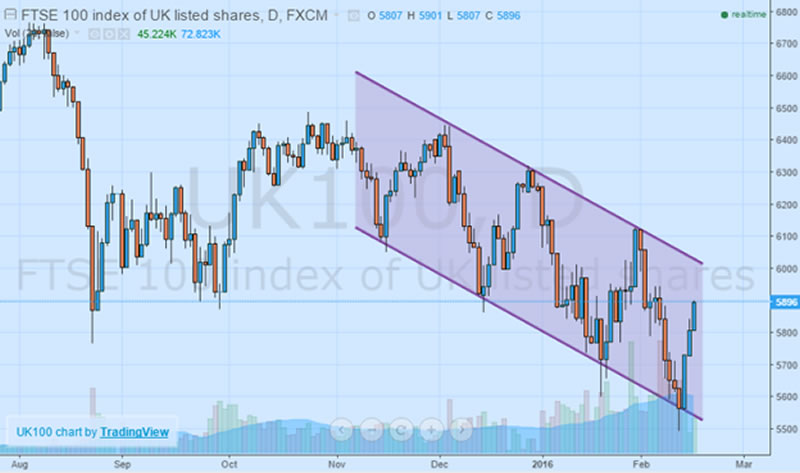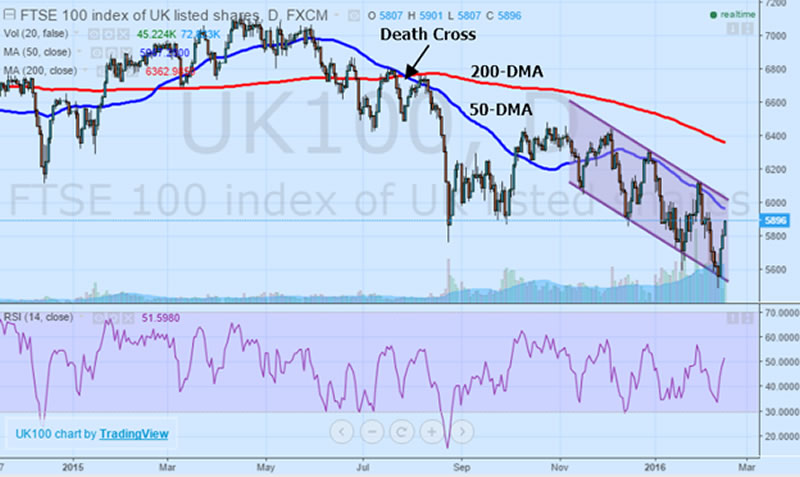FTSE Bounce to Prove Brief
Stock-Markets / UK Stock Market Feb 17, 2016 - 03:30 PM GMTBy: AnyOption

 The bounce in capital markets across the globe amid speculation of expanded stimulus from the European Central Bank and looser lending conditions in China may have sent risk assets and equities higher, but the positive sentiment is unlikely to last. Worsening fundamental conditions in the United Kingdom combined with a weak external environment have contributed to the sizable decline in FTSE 100 equity index over the last several months, with the benchmark dipping into a bear market last month following a widespread market selloff. A number of lingering issues continue to plague the index, keeping the pressure on performance high as concerns about the drag from energy, softer industrial activity, and another bout of regional bank weakness are offset gains from a more competitive Pound.
The bounce in capital markets across the globe amid speculation of expanded stimulus from the European Central Bank and looser lending conditions in China may have sent risk assets and equities higher, but the positive sentiment is unlikely to last. Worsening fundamental conditions in the United Kingdom combined with a weak external environment have contributed to the sizable decline in FTSE 100 equity index over the last several months, with the benchmark dipping into a bear market last month following a widespread market selloff. A number of lingering issues continue to plague the index, keeping the pressure on performance high as concerns about the drag from energy, softer industrial activity, and another bout of regional bank weakness are offset gains from a more competitive Pound.
Index Echoing Declining Fundamentals
Looking at the sector weightings of the FTSE 100, it is not difficult to conclude as to why performance in the index has been lackluster, especially after a dismal 1-year return of -15.26%. The big picture breakout of the FTSE 100 shows concentrations in four key areas, with the personal/household sector accounting for 13.64% of the total weighting, followed by oil & gas at 12.82%, banks at 12.10% and healthcare at 10.37%. Starting with consumption, wage growth remains in positive territory but is nevertheless modest at best with retail sales growth still decelerating and possible deflation, a number of factors could hurt the outlook. Healthcare equipment have been strong performers amid the weakening backdrop, rising 2.31% year over year. However, the real losses will continue to be attributed to energy and banking.
The collapse in commodity prices over the last year has had a widespread impact, especially on mining and energy extraction operations across the UK. For local firms it has been nothing short of a disaster, especially in the North Sea as plunging energy prices has seen widespread reductions in headcounts with profitability suffering. The oil equipment sector in particular has been hard hit, tumbling 33.62% over the prior year while producers have fallen by -22.69%. However, it is not the only drag especially as the “Brexit” talks heat up, impacting banks as it raises concerns about London remaining the global banking center. Additionally, UK banks are under pressure thanks to widespread weakness across the European banking sector as old problems resurface. Even with a cheaper Pound supporting shares on a relative value basis, the headwinds are too numerous to be overcome short-term as companies hunker down.
Technically Speaking
While a modest global bounce in risk assets across the globe is to be expected after the prior week’s losses, from a technical perspective there is still plenty of room for a deeper downward correction in the FTSE 100, especially after the benchmark dropped into a bear market back in January. The FTSE 100 has been trading within a downward trending equidistant channel formation for the better part of the last three months, adding to the prevailing bearish bias. Although the Index has managed to bounce back from the prior week’s losses after Central Bank’s pledged to do more and following the latest lending data from China, the pattern remains intact, with any bounce presenting a useful opportunity to establish short positions in the index just slightly below 6000 with a target of 5500.

Adding to the downward narrative are the moving averages and relative strength index. Even though the relative strength index is currently sitting in the middle of the range, should the signal line continue to rise rise above the 60-70 level, it could be highly indicative of a great entry point for potential short positions attempting to capitalize on the medium-term downtrend and renewed momentum lower. The moving averages are also trending lower above the FTSE 100 price action, adding to the downside case with both the 50 and 200-day moving averages acting as resistance. Should the FTSE 100 bounce of the rapidly approaching 50-day moving average, it could signal a great potential entry point. With the medium-term moving average crossing the longer-term moving average to the downside back in July, the “death cross” formation is also still in play.

The Big Picture
Both fundamentally and technically speaking there is a good case for further downside in UK shares over the medium-term as a number of factors contribute to the FTSE 100 index’s recent demise. Although the benchmark has bounced back from a string of recent losses, this does not necessarily make the case for a reversal in the trend lower, but merely resembles a pullback as evidenced by technical factors that exhibit a largely bearish bias. Combined with the projected weakness in both the energy and banking sectors over the next few months and the Index is set for another wave of losses. Although there might be a little more left in the recent risk bounce, the upside in the FTSE 100 should be looked upon as limited as downside risks escalate.
Anyoption™ is the world's leading binary options trading platform. Founded in 2008, anyoption was the first financial trading platform that made it possible for anyone to invest and profit from the global stock market through trading binary options.
Our goal here at Market Oracle is to provide readers with valued insights and opinions on market events and the stories that surround them.
Website anyoption.com
© 2016 Copyright Anyoption - All Rights Reserved
Disclaimer: The above is a matter of opinion provided for general information purposes only and is not intended as investment advice. Information and analysis above are derived from sources and utilising methods believed to be reliable, but we cannot accept responsibility for any losses you may incur as a result of this analysis. Individuals should consult with their personal financial advisors.
© 2005-2022 http://www.MarketOracle.co.uk - The Market Oracle is a FREE Daily Financial Markets Analysis & Forecasting online publication.


